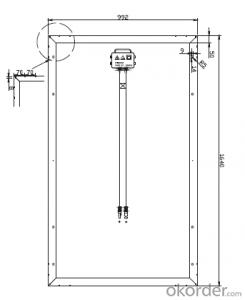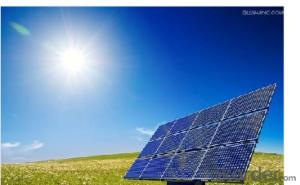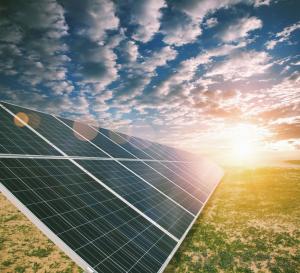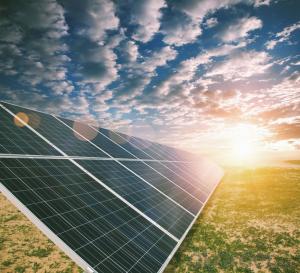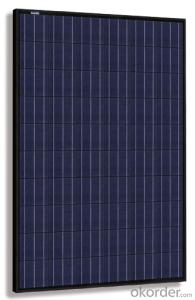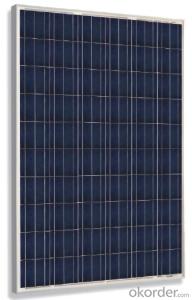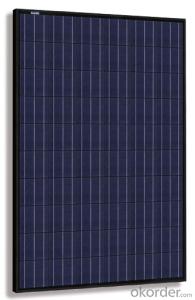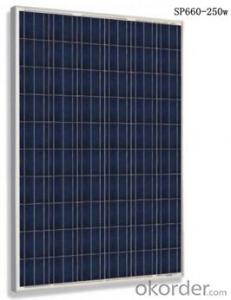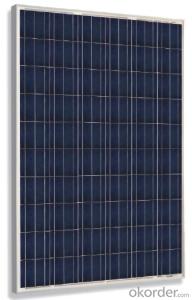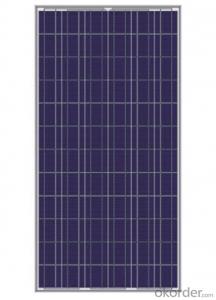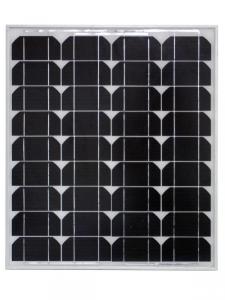Best Home Solar Panels - Polycrystalline Solar Module SP660-240W
- Loading Port:
- Shanghai
- Payment Terms:
- TT OR LC
- Min Order Qty:
- 25 set
- Supply Capability:
- 8000 set/month
OKorder Service Pledge
OKorder Financial Service
You Might Also Like
Product Description:
1.Structure of Polycrystalline Solar Module SP660-240w Series Description:
Polycrystalline Solar Module SP660-240w : High efficiency crystalline solar cell. Even if under the weak light, the solar module can produce maximum power output.
II Tempered glass (toughened glass): Anti-reflecting coating and high transmission rate glass increase the power output and mechanical strength of solar module.
III EVA and TPT: Using high quality EVA and TPT to prevent destroying and water.
IV AI frame: Without screw, rner connection. 6 holes on the frame can be installed easily.
V Junction box: Multi function junction box with water proof.
VI Long lifetime: ≥25 years; Less power decrease.
VII Good performance of preventing from atrocious weather such as wind and hails.
VIII Resisting moisture and etching effectively, not effected by geology.
IX The certificate issued by international authority: TUV, IEC, CE.ISO9001.MCS
2. Standard Test Conditions of Polycrystalline Silicon Solar Panel:
The opto-electrical specifications shown below are stabilized values being measured at Standard Test Conditions, Irradiance: 1000W/m2, Spectrum: AM1.5 at 25°C, The info below is subject to manufacturing tolerances. Where appropriate minutes of measurement are available and are used for the dimensioning of the installation.
Advantages of Polycrystalline Silicon Solar Panel
• 25 year transferrable power output warranty: 10 years / 90%, 25 years / 80%*
• 12 year material and workmanship warranty
• Timeliness of delivery
• Quality Products certified (TUV, IEC, CE.ISO9001.MCS)
3. Characteristics of PolycrystallineSilicon Solar Panel:
• Guaranteed tolerance +3%
• High manufacture standards
• Reliable power output
• High module efficiency
• Module efficiency up to 15.5%
• Cells efficiency up to 17.6%
• Strong compressive strength
• Certified to withstand high wind of 2400Pa
4. Solar Panel Images
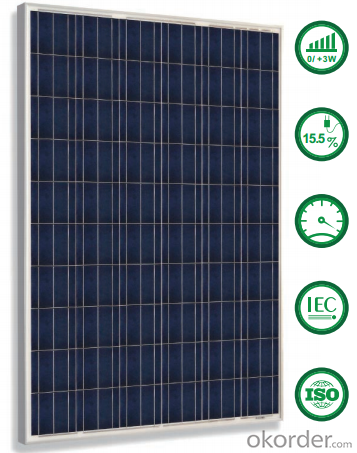
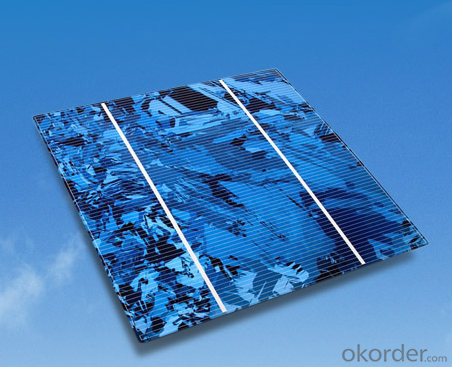


5. Polycrystalline Silicon Solar Panel Specification
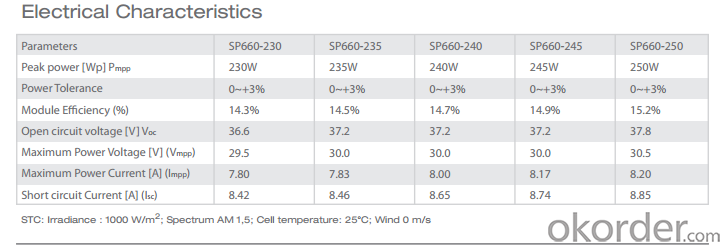
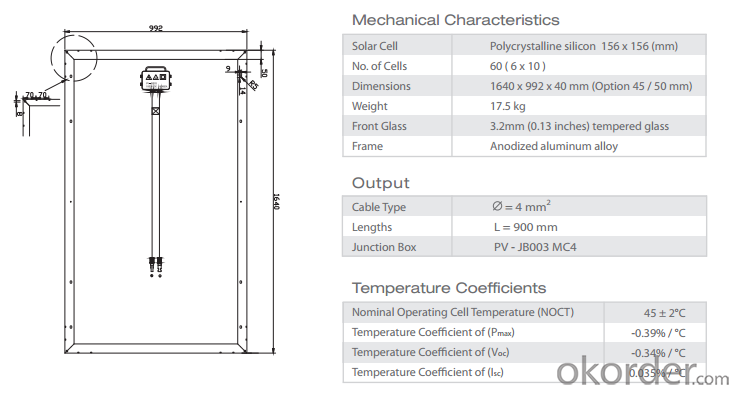


6.FAQ
We have organized several common questions for our clients,may help you sincerely:
①How about your company?
We are a private-owned high-tech company who specializes in developing, manufacturing and marketing of silicon ingots, solar wafer, solar cells, solar modules, PV systems and solar applications products.
At present, We has one research & development team, whose members are well-known experts in photovoltaic area. We also have advanced production and test equipment.
②How to guarantee the quality of the products?
Our products have been certified by CE, CEC,MCS, IEC61215, IEC61730 and ISO9001.
• 25 year transferrable power output warranty: 10 years / 90%, 25 years / 80%*
• 12 year material and workmanship warranty
• Timeliness of delivery
• Quality Products certified (TUV, IEC, CE.ISO9001.MCS)
③How long can we receive the product after purchase?
In the purchase of product within three working days, We will arrange the factory delivery as soon as possible. The pecific time of receiving is related to the state and position of customers.Commonly 7 to 10 working days can be served.
- Q: The first panel is located in New England, the second is placed in the Sahara desert, the third is on the Earth side of the moon, and the last is on the far side of the moon. Which panel would absorb the most sunlight over a year's time and why ? All the panels are place in optimal places where they would get the most light available.
- Best to worst: far side of the moon, near side of the moon (same as far side, except for lunar eclipses), Sahara desert (not at 0 latitude, and occasional bad weather), New England (less favorable latitude, and LOTS of bad weather).
- Q: Are there any noise concerns with solar panels?
- No, there are no noise concerns with solar panels. Solar panels produce electricity by converting sunlight into energy and do not generate any noise during their operation.
- Q: I jotted down some notes for my Technology and Architecture class and I'm trying to figure out what i meant when i said 'Treated with gases at extremely high temperatures.' I have NO idea what I was talking about :) Im trying to figure out if what I am talking about is about Silicon, Polychristaline, or a Solar Cell/Panel.
- Let me help you get an idea of what you are talking about as your notes seems a bit jumbled. Mostly when they refer to a silicon solar cell they mean that the silicon is one crystal of silicon. (very much like a diamond, but with atoms of silicon instead of carbon). A single perfect crystal of silicon can be grown that is very large at temperatures near the melting point of silicon or around 400C and then is sawed up to create electronics or solor cells. Polycrystalline :) solar cells are also made of silicon, but instead of a single crystal it is made of a jumble of small crystals that have different sizes and directions. So these types of solar cells can be made using a silicon gas (siline: SiH4) at much lower temperatures 600-700C. So these are less expensive to make, but because they are not perfect crystals a poly solar panel that is the same size as a crystalline solar panel will make less energy. I hope that helps.
- Q: i already have solar/gas water heating, but was wondering if getting solar panels for electricity installed was a good idea.
- Sure they work, photovoltaics. Light goes in, electricity goes out. Is it a good idea? Well. See, they're expensive. You probably need several kilowatts of capacity to run your house for one thing, and that's going to require several thousands of dollars worth of panels. And electricity doesn't cost that much. You can figure out how long it would take you to make the expense back. It would be a while. It would take even longer if you wanted to spring for a system that could take you completely off the grid, that would require banks of deep cycle batteries too. But most people are probably fine with a system that ties into the grid, and depending on who your utility is you may be able to sell surplus power back to them. Expense is the main reason I think you don't see a huge number of people adopting photovoltaics yet. Doesn't explain why solar heating isn't more popular though. That's really cheap and practical by comparison. But yeah you can find the photovoltaic panels for sale all over the place. Google it. Yeah the going rate for panels is around 2 bucks a watt.
- Q: Can solar panels be used to power streetlights or outdoor lighting?
- Yes, solar panels can be used to power streetlights or outdoor lighting. Solar panels convert sunlight into electricity, which can be stored in batteries and used to power streetlights or outdoor lighting fixtures during nighttime. This helps to reduce reliance on traditional grid-based electricity and promotes more sustainable and environmentally friendly lighting solutions.
- Q: Can solar panels work in cloudy weather?
- Yes, solar panels can still generate electricity even in cloudy weather. While direct sunlight produces the most optimal conditions for solar panel efficiency, they can still function and generate power in cloudy weather due to their ability to convert diffused sunlight into electricity. However, the electricity output may be lower compared to sunny days.
- Q: I am planning to run a couple of dc motors on solar current. I have a couple of 450mA 4V, 200mA .5V, 00mA 9V solar panels with me. I need to run a pair of .5A 9V motors. Suggest me a circuit along with other equipments I might require. For your info, I am trying to build a solar powered drone / UAV
- I don't think it is enough solar power. Your motor requires .5A x 9V = 3.5 watts. The solar cells are .450A x 4V x 2ea. = 3.6 watts, .2A x .5V = .3 watts, .A x 9V = .9 watts total solar = 4.8 watts. The problem with connecting the cells in series to get the right voltage, like the two 4V cells in series with the .5 volt cell (total 9.5 volts) is that the .5 volt cell limits the maximum current to only 0.2A. If you paralleled that with the 9V cell, you would get 9 volts at 0.2 + 0. = 0.3A, too low to operate the motor at its design current and voltage. The best you could do is put the two 4V cells in series, and in parallel with the 9V cell (a blocking diode might be a good idea, but probably not required for such a small array). That way you get 8 volts at 0.55 amps.
- Q: What is the lifespan of a solar panel?
- The lifespan of a solar panel typically ranges from 25 to 30 years, depending on various factors such as the quality of the panel, maintenance, and environmental conditions.
- Q: Do solar panels require a battery for energy storage?
- No, solar panels do not require a battery for energy storage. However, if you want to store the excess energy generated by the panels for use during non-sunny periods or at night, a battery storage system can be installed.
- Q: The inverter I am using gets the required 2 DC volts from the solar panel, but fo some reason it just won't output the 0 AC voltage. When the inverter is hooked to a car battery, it works just fine off the same 2 DC rating. Help me out please...
- There could be a couple of reasons why it isn't working. First, 2V panels actually put out a considerably higher voltage because it is presumed that they will be used to charge a 2Vdc battery. That requires applying a voltage greater than 2Vdc, and usually there is a solar controller that regulates the solar power to the battery. It also has a voltage drop. Look at the first reference reference, and you will see these values for a particular panel: Voc: 2.6V (open circuit voltage) Vmp: 7.2V (voltage at maximum power point) Voc is the voltage the panel produces under standard sunlight and temperature conditions (25°C), with no load applied. As load is applied, the voltage drops (see reference 2). Power is the product of current times voltage, so at one set of conditions (namely at Vmp) maximum power is available from the panel. Your inverter might not be working for either of two reasons: ) it has input protection circuitry that locks out operation when it senses an overvoltage, as in the 2.6V open circuit voltage, or 2) the panel does not produce enough current and the voltage from the panel collapses under excessive load. For example, if you load your inverter to 20W, then nominally the 2VDC input to the inverter must supply 20W/2V/eff = 0A/eff Assuming the inverter has an efficiency of 80%, the input current required is: 0A/.8 = 2.5A A solar panel operating at maximum power would need a rating of about: 2.5A x 7.2V = 25W Is your panel that big? The other option, as mentioned by others, is to charge a battery that runs the inverter. Other nuances: Voc increases as temperature decreases. Sunlight intensity varies (obviously), so the panel may produce less than rated power. The power specifications often are printed on the back side of the panel.
Send your message to us
Best Home Solar Panels - Polycrystalline Solar Module SP660-240W
- Loading Port:
- Shanghai
- Payment Terms:
- TT OR LC
- Min Order Qty:
- 25 set
- Supply Capability:
- 8000 set/month
OKorder Service Pledge
OKorder Financial Service
Similar products
Hot products
Hot Searches
Related keywords
